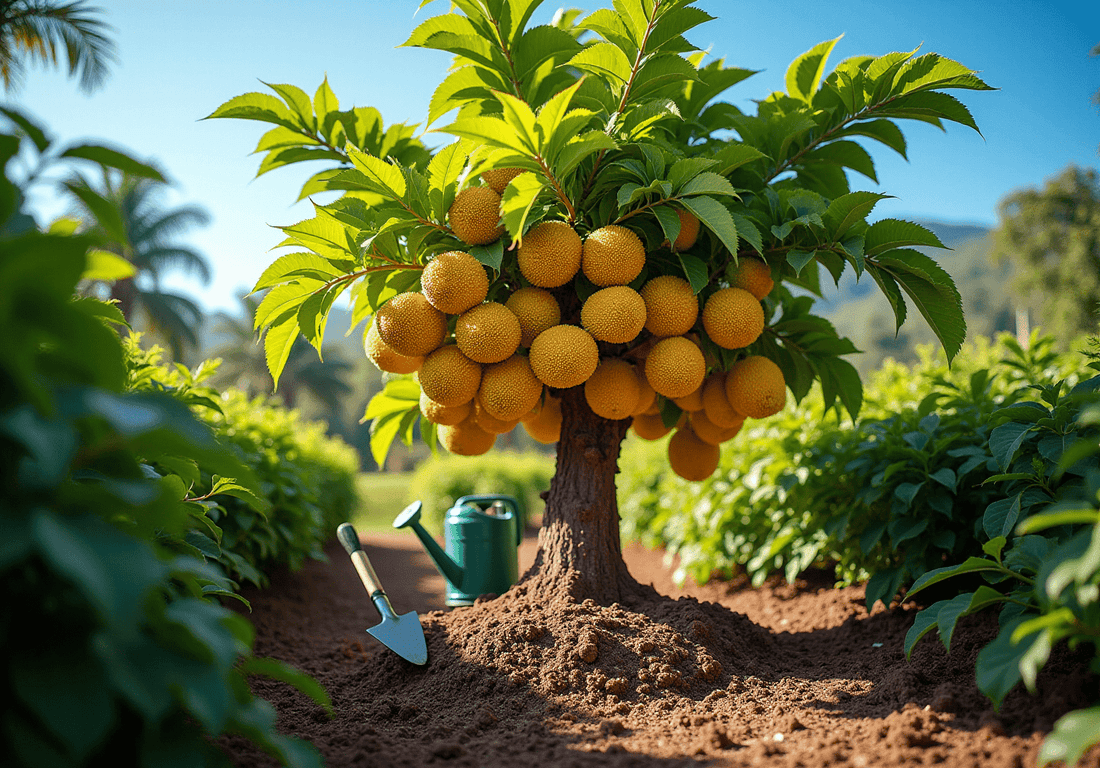
Master the Art of Growing Your Lara Star Fruit Tree
Share
Cultivating a Lara Star Fruit tree can be a rewarding endeavor, offering both lush greenery and delicious fruit. Understanding the specific conditions that these tropical trees require is crucial for successful growth. This guide unveils the essential steps for planting and maintaining a thriving Lara Star Fruit tree, while also addressing common challenges that gardeners may face. How can one ensure that their tree not only survives but flourishes, yielding a bountiful harvest year after year?
🌱 Want to grow a Star Fruit Tree in your garden?
Explore Lara Star Fruit Trees sale at Everglades Farm - shipped directly from Florida.
1. Understand Ideal Growing Conditions for Lara Star Fruit Trees
Lara Star Fruit trees thrive in warm, humid environments typical of tropical and subtropical climates. They perform optimally in full sun, ideally receiving at least 6 to 8 hours of direct sunlight daily. The ideal temperature range for their growth lies between 68°F and 95°F (20°C to 35°C). Protecting these plants from frost is crucial, as they are sensitive to temperatures dropping below 30°F (-1°C).
Selecting a planting site with good air circulation is essential to prevent fungal diseases and encourage vigorous growth. When planting multiple star fruit trees, ensure they are spaced 10 to 15 feet apart to accommodate their expansive canopy. These trees prefer well-draining, slightly acidic soil with a pH between 5.5 and 6.5.
Regular watering is vital to maintain consistently moist soil without causing waterlogging, which is critical for their health. Additionally, monitoring soil pH levels is important to prevent stunted growth and nutrient deficiencies. By following these care practices, gardeners can successfully cultivate healthy lara star fruit trees.
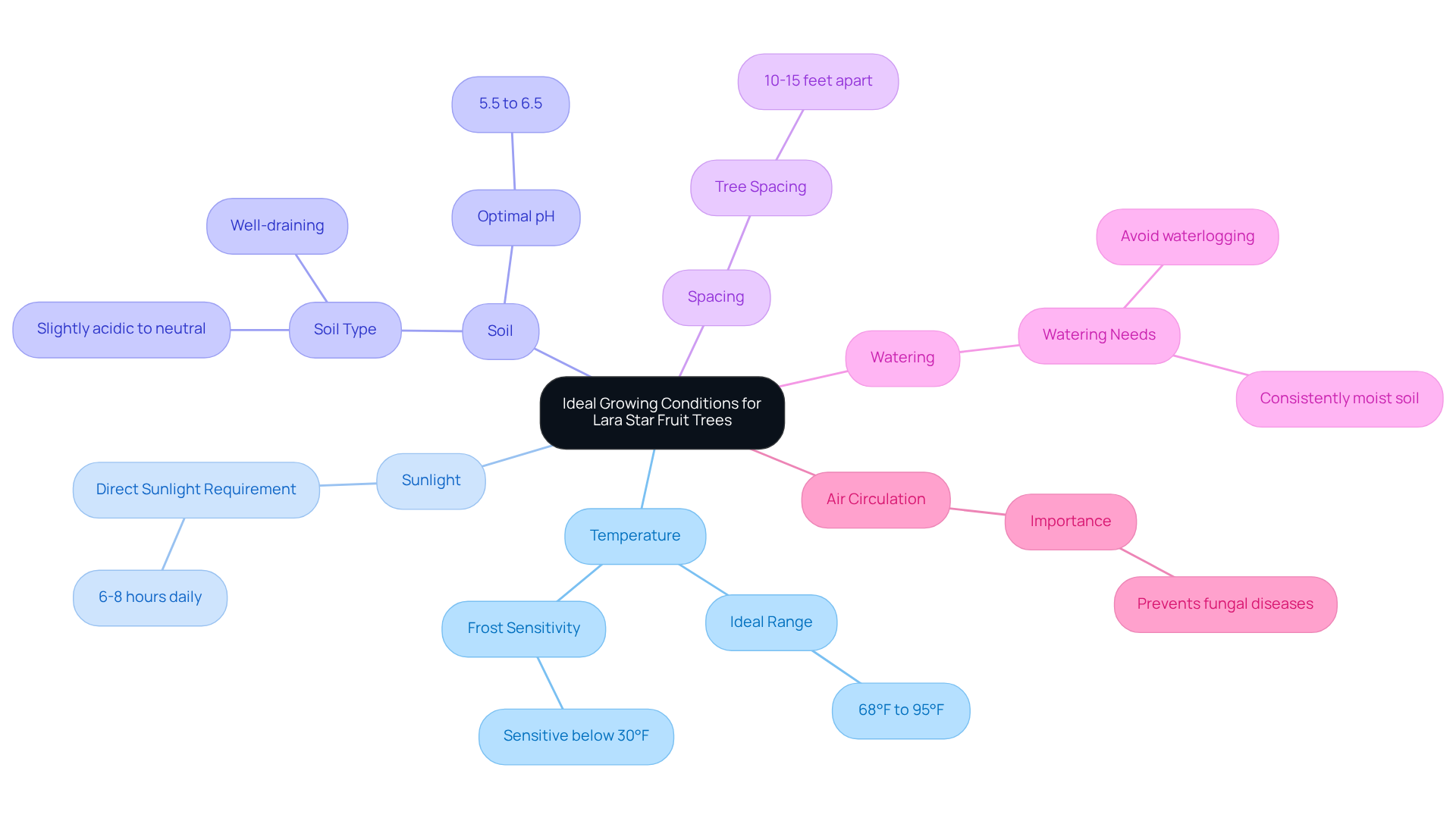
2. Prepare Soil and Select the Right Planting Site
To successfully cultivate your lara star fruit tree, it is essential to begin by selecting a planting site with well-draining sandy loam or loamy earth. This soil type is ideal for promoting healthy root growth. The optimal pH level for these plants is somewhat acidic, preferably ranging from 5.5 to 6.5. Prior to planting, enriching the soil with organic matter, such as compost, enhances fertility and moisture retention, which are vital for the plant's development.
When creating the planting hole, ensure it is twice as wide and deep as the root ball of the plant. This allows ample space for root expansion, which is crucial for the plant's overall health. Additionally, select a site that is protected from strong winds and receives direct sunlight for a minimum of 6 to 8 hours each day. Such exposure is essential for the growth and fruit production of the lara star fruit tree, ensuring a bountiful harvest.
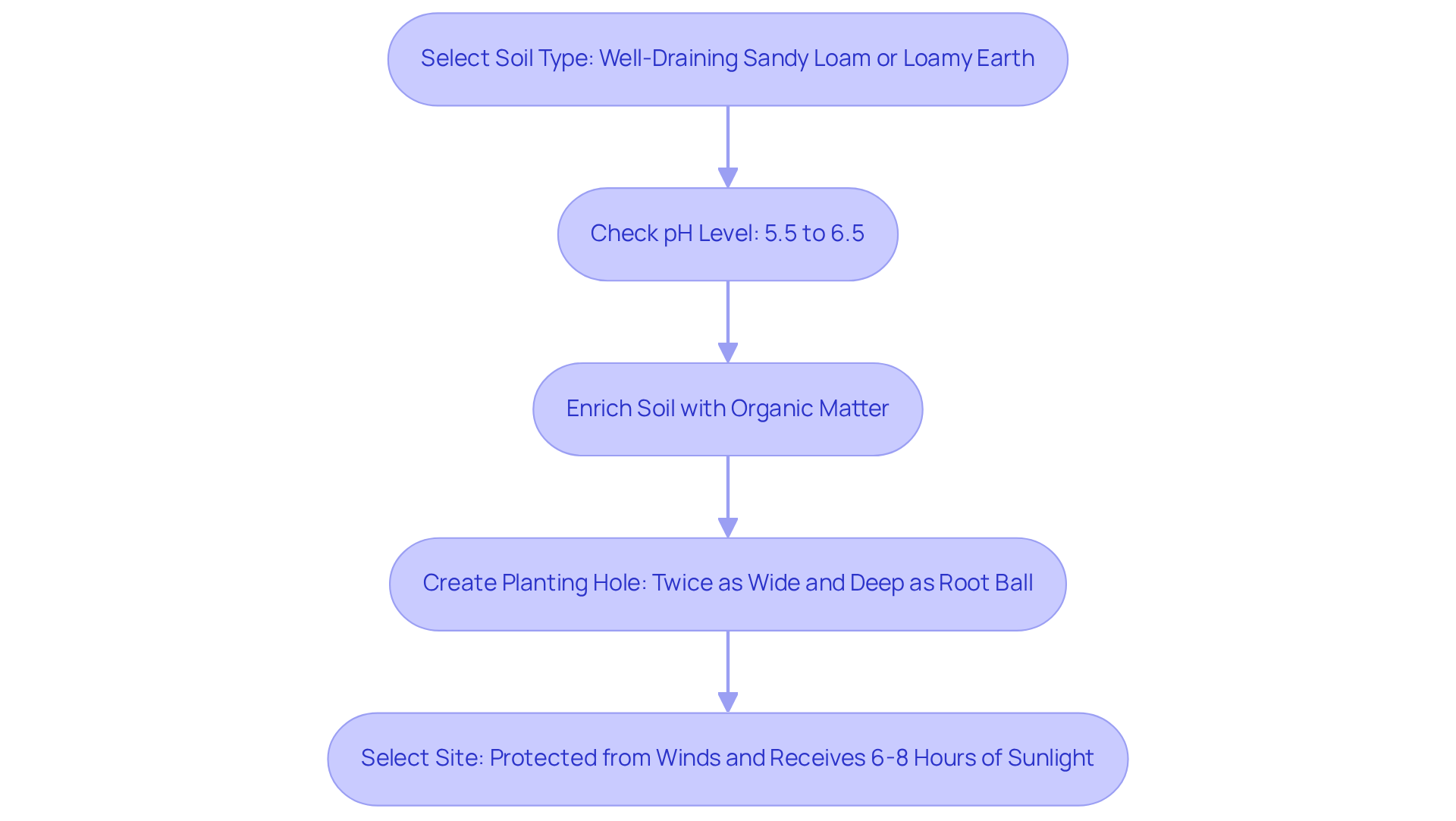
3. Plant Your Lara Star Fruit Tree Correctly
To successfully plant your lara star fruit tree, follow these essential steps:
- Gently remove the lara star fruit tree from its container, taking care to minimize disturbance to the roots.
- Position the plant in the center of the prepared hole, ensuring that the top of the root ball is slightly above ground level. This positioning is crucial as it facilitates proper oxygen availability and helps prevent moisture-related issues.
- Refill the hole with the original soil mixed with 10 to 20 percent compost, compacting it carefully to eliminate air pockets that could hinder root development.
- After planting, water the plant thoroughly to settle the soil around the roots, ensuring they are well-hydrated.
- Finally, apply a layer of mulch around the base of the plant to retain moisture and suppress weed growth, thereby creating an optimal environment for your plant to thrive.
Remember, the first year is critical for establishing a healthy root system, so consistent care and attention are essential.
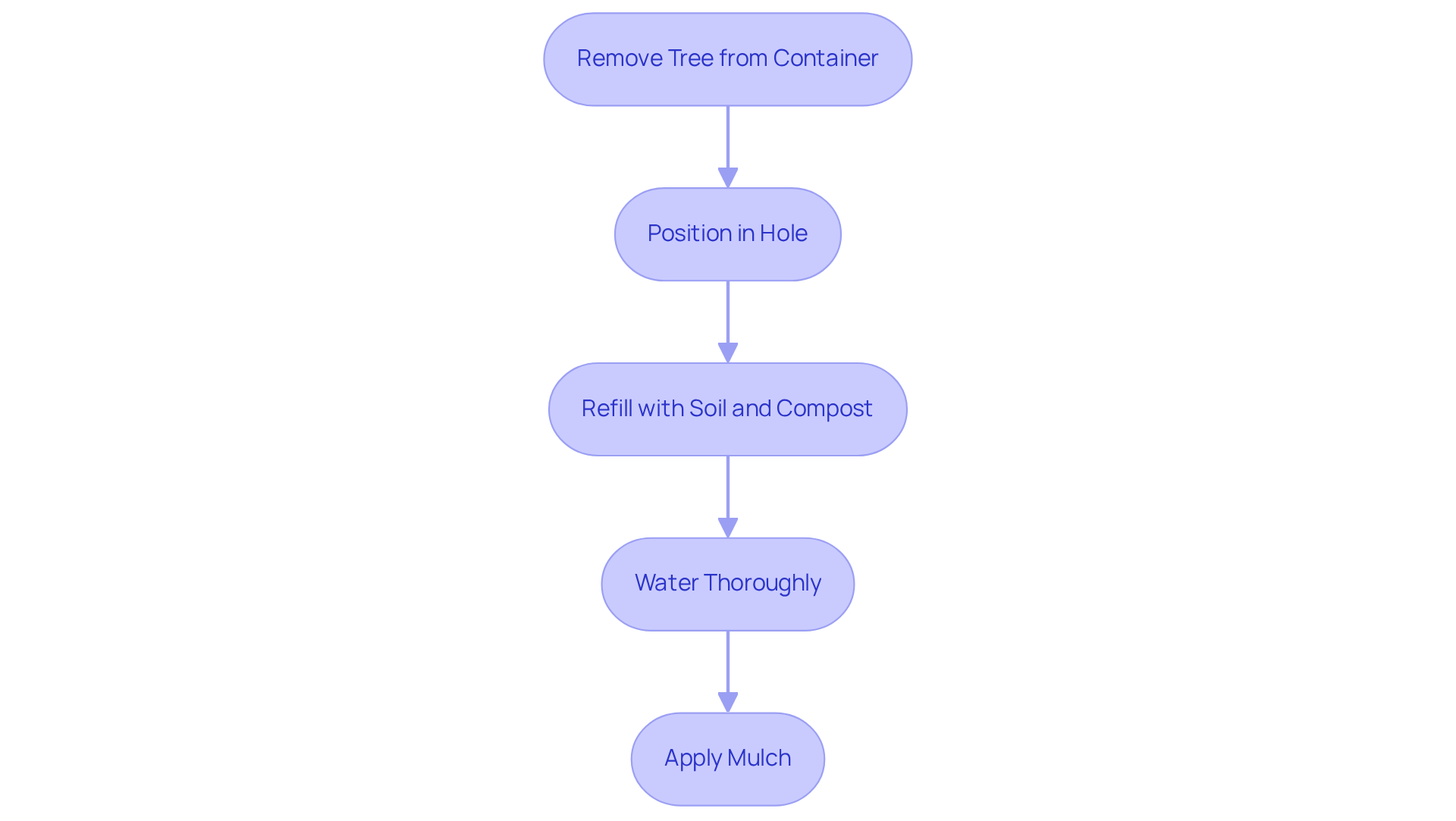
4. Maintain and Care for Your Lara Star Fruit Tree
To ensure the health and productivity of your Lara Star Fruit tree, it is essential to adhere to the following care guidelines:
-
Watering: Regular watering is crucial, especially during dry spells. Aim for deep watering once a week to maintain consistently moist soil without becoming waterlogged. Mature plants typically require about 200 liters of water weekly during peak summer months, while younger plants may need more frequent watering to establish their root systems.
-
Fertilization: Apply a balanced, slow-release fertilizer every 6-8 weeks throughout the growing season. This practice is vital for fostering strong development and improving yield. Nutritional management is key; research indicates that appropriate fertilization significantly impacts the development rates of star fruit plants.
-
Pruning: Lightly trim your plant to remove any dead or damaged branches. This practice not only aids in shaping the plant for improved air circulation but also promotes healthy growth and fruiting.
-
Pest Monitoring: Keep a vigilant eye out for common pests such as aphids and scale insects. Promptly address any infestations using organic insecticides or neem oil to safeguard the health of your plant.
By following these guidelines, you can nurture a flourishing lara star fruit tree that produces delectable fruit while enhancing the vibrancy of your garden.
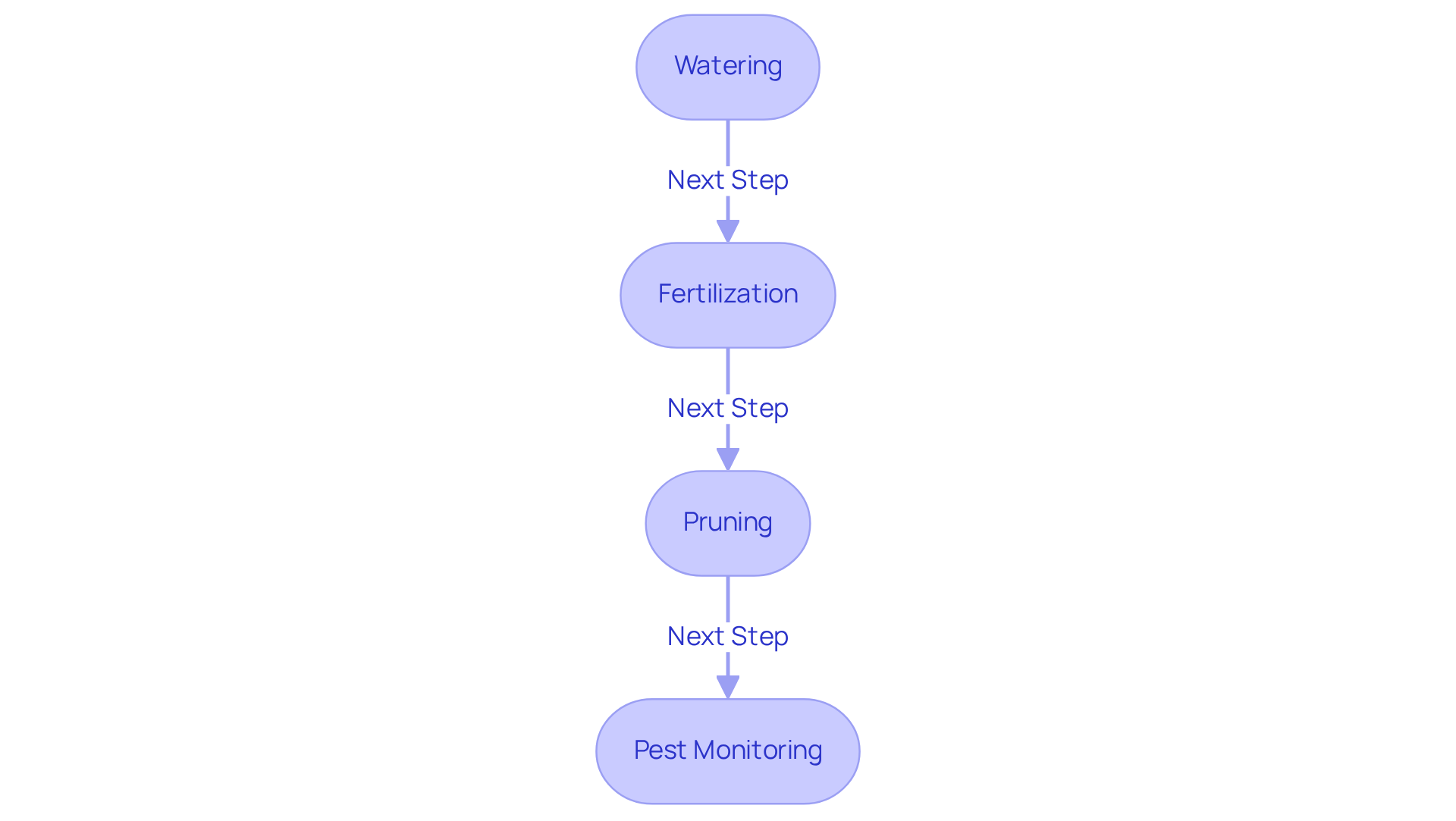
5. Troubleshoot Common Growing Issues
Common issues with the lara star fruit tree often manifest as yellowing leaves, which can indicate nutrient deficiencies, particularly in nitrogen or iron. To address this, applying a balanced fertilizer or a foliar spray of chelated iron is recommended. The typical nitrogen requirements for these plants range from 0.01 to 0.04 lbs N per specimen per year of age, with a maximum application limit of 0.3 lbs N per specimen annually. Additionally, if you notice fruit drop, it may result from inadequate watering or stress due to temperature fluctuations. It is essential to ensure consistent watering and protect the plant from extreme weather conditions.
Moreover, vigilance against pests such as flies and aphids is crucial; regular inspections and timely treatments can prevent infestations from worsening. Agronomists note that nutrient deficiencies are prevalent in tropical plants, and understanding these can significantly enhance management strategies. Incorporating organic matter into the soil improves its structure and nutrient availability, thus promoting overall plant health.
Spring is typically the ideal time to fertilize fruit plants, as they are in their active growth phase and can effectively absorb nutrients. By proactively managing these aspects, gardeners can cultivate healthier and more productive lara star fruit trees.
Conclusion
Mastering the cultivation of a Lara Star Fruit tree necessitates a thorough understanding of its specific needs and optimal growing conditions. By ensuring the right climate, soil, and care practices, gardeners can create a thriving environment that fosters the health and productivity of these unique trees.
Key considerations include:
- Selecting a suitable planting site that receives ample sunlight
- Utilizing well-draining soil
- Ensuring proper spacing to encourage growth
- Regular watering
- Appropriate fertilization
- Vigilant pest management
These are essential for nurturing the tree throughout its life cycle. Additionally, recognizing and addressing common issues, such as nutrient deficiencies and pest infestations, can significantly enhance the success of growing a Lara Star Fruit tree.
Ultimately, the journey of cultivating a Lara Star Fruit tree transcends the final product; it embodies the joy of nurturing a living organism and contributing to a vibrant garden. By applying the insights and techniques outlined, anyone can embark on this rewarding gardening adventure, fostering not only the tree's growth but also a deeper connection to nature.
Grow Your Own Tropical Paradise Today!
Start your journey with Everglades Farm and nurture your Lara Star Fruit tree to life.
Frequently Asked Questions
What are the ideal growing conditions for Lara Star Fruit trees?
Lara Star Fruit trees thrive in warm, humid environments typical of tropical and subtropical climates, with optimal conditions including full sun exposure for at least 6 to 8 hours a day and temperatures between 68°F and 95°F (20°C to 35°C).
How sensitive are Lara Star Fruit trees to temperature changes?
Lara Star Fruit trees are sensitive to frost and should be protected from temperatures dropping below 30°F (-1°C).
What type of soil is best for planting Lara Star Fruit trees?
Lara Star Fruit trees prefer well-draining, slightly acidic soil with a pH between 5.5 and 6.5, ideally sandy loam or loamy earth.
How should I prepare the soil before planting a Lara Star Fruit tree?
Enrich the soil with organic matter, such as compost, to enhance fertility and moisture retention before planting.
What spacing is recommended when planting multiple Lara Star Fruit trees?
When planting multiple trees, they should be spaced 10 to 15 feet apart to accommodate their expansive canopy.
What is the importance of watering for Lara Star Fruit trees?
Regular watering is vital to maintain consistently moist soil without causing waterlogging, which is critical for the health of the trees.
How can I ensure healthy root growth for my Lara Star Fruit tree?
When creating the planting hole, make it twice as wide and deep as the root ball of the plant to allow ample space for root expansion.
What factors should be considered when selecting a planting site for Lara Star Fruit trees?
Choose a site with good air circulation, protection from strong winds, and direct sunlight for a minimum of 6 to 8 hours each day to promote healthy growth and fruit production.

